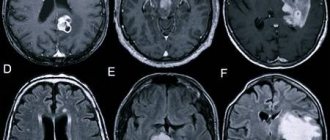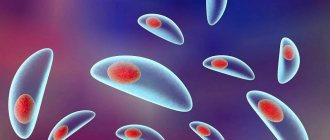- Home /
- Branches /
- Endocrinology /
- Acromegaly and gigantism
10/08/2021 The article was checked by an endocrinologist, Ph.D. Mirna S.S. , is for general informational purposes only and does not replace specialist advice.
For recommendations on diagnosis and treatment, consultation with a doctor is necessary. Acromegaly and gigantism are chronic diseases caused by excessive secretion of growth hormone by the pituitary gland.
Acromegaly develops mainly in adults; Gigantism manifests itself already in childhood.
Classification of gigantism
According to modern endocrinological classification, the following types of gigantism are distinguished:
- true gigantism, a characteristic feature of which is a proportional increase in all parts of the body, while the mental and functional development of the body remains normal;
- acromegalic gigantism (signs of acromegaly are added);
- splanchomegaly: with this type of gigantism, there is an increase in the size and mass of internal organs; in some sources, this disease is referred to as “gigantism of internal organs”;
- eunuchoid gigantism, a pathology whose main feature is a decrease in functionality or complete dysfunction of the gonads. Such patients have virtually no secondary sexual characteristics, have disproportionately elongated limbs and open growth zones in the joints;
- partial or partial gigantism is accompanied by an increase in individual parts of the body;
- half gigantism is characterized by an increase in the body on one side;
- cerebral gigantism: associated with an organic disorder of the brain and entails intellectual disorders.
More about symptoms
Signs of gigantism begin to appear in adolescence. Quite often, at the initial stage, parents do not give due importance to their children’s complaints. And the rapid growth is justified by the tallness of close relatives.
Evidence of gigantism may include:
- constant severe weakness;
- daily dizziness;
- chronic headaches;
- memory problems;
- tachycardia.
During puberty, girls may not have periods even at 15-16 years old. Breast development may be slow. Boys over the age of 14 may suffer from hyposexuality (lack of sexual desire). The development of macrogenitalism, expressed in exceeding the norm for the size of the penis, is possible.
In most cases, mental development is impaired. For “giants,” a tendency toward apathy, persecution mania, and preservation of “childishness” despite growing up is considered quite typical.
Condition of organs and body parts
Seeing giant people, one gets the impression that everything internal to such a person is also large. This is true, but not all internal organs increase, despite the high growth of the body. Thus, the most important organ, the heart, does not have time to grow. Due to its insufficient size, the heart cannot cope with its functions, which is fraught with multiple complications.
Gigantism is often accompanied by the following deviations:
- macroglossia (large tongue);
- diastema (increased distance between teeth);
- enlargement of the larynx.
Despite the fact that, except for the heart, all organs are sized according to the patient’s height, they still do not function fully, therefore, with gigantism there are multiple complications.
Causes of gigantism
The underlying cause of gigantism is excessive production of somatotropin, which in turn can be provoked by the following pathologies:
- intoxication (increased levels of toxins in the body);
- neoplasms of the adenohypophysis;
- traumatic brain injuries;
- neuroinfections - infectious (bacterial or viral) diseases of the central nervous system, such as encephalitis, meningitis, meningoencephalitis.
In addition to all of the above, the cause of gigantism may be a low level of sensitivity of the receptors of the epiphyseal cartilage (the area of the bone from which it grows in length) to the hormones responsible for sexual development, this provokes the ability of bones to grow (bone growth zones remain open), even after end of puberty (7-13 years).
Why growth doesn't stop
The disease gigantism has not been fully studied by medicine, but already in 1990 it was revealed that macrosomia is associated with a somatotropin tumor, which develops under the influence of eosinophils, which are involved in the formation of the hormone - somatotrope. Somatotropinomas are characterized as benign formations. However, the risk of developing a cancerous form cannot be ruled out. The location of the tumor in gigantism is the thyroid gland. Somatotropinomas are not the only cause of pathological human growth. This tumor provokes gigantism in only 1% of patients.
About 9% of people suffer from macrosomia, which occurs as a result of the development of adrenohypophyseal microadenoma (a tumor of the pituitary gland up to 10 mm in size). In 90% of cases, the cause is macroadenoma (a tumor that develops with the uncontrolled proliferation of pituitary cells).
Possible causes of gigantism include:
- sensitivity of cartilaginous epiphyseal receptors to growth hormones;
- genetic predisposition;
- neuroinfections;
- severe intoxication;
- traumatic brain injuries;
- hyperplasia of pituitary cells;
- Albright and Carney syndromes;
- endocrine neoplasia;
- neurofibromatosis.
Gigantism can be triggered by autoimmune diseases, long-term treatment with hormones, severe general infection of the body, or cerebrovascular accident.
Symptoms of gigantism
The main symptom of gigantism is a significant increase in body parts. As a rule, the main growth spurt occurs in childhood (10-15 years). Patients experience high growth rates that are unusual for the normal physiological development of the human body. Patients experience subjective complaints of headaches, dizziness, increased fatigue, pain in the bones and joints, and decreased vision. Deterioration of memory and performance leaves its mark on school performance.
Gigantism is accompanied by neuropsychiatric disorders, as well as sexual dysfunctions (infantilism). In men with gigantism, hypogonadism develops, in women - early cessation of menstrual function or amenorrhea, as well as infertility. Other hormonal pathologies that may be symptoms of gigantism include:
- sugar;
- diabetes insipidus;
- hyper-hypothyroidism.
Gigantism is initially manifested by an increase in muscle mass, and then muscle weakness and asthenia occur.
General information
Gigantism is rare and is not considered an exceptional disease. According to statistics, the disease is diagnosed in 3-4 out of 1000 people. The disease is directly related to neuroendocrine disorders and is caused by an increase in the production of somatotropin, which is an endocrine hormone that regulates human growth.
Macrosomia, as a rule, is diagnosed in childhood, since pathological abnormalities begin to appear in children 9 to 14 years old, when the child’s growth spurt occurs, but the ossification processes have not yet begun. By the age of 16 - 18, height can be more than 1.9 m for both girls and boys.
Pathologically high growth is dangerous for the body by developing complications. Modern medicine has learned to combat this disease, but if treatment measures are not taken, life expectancy can be greatly reduced. Treatment should begin as early as possible, in this way it will be possible to restore the functionality of the pituitary gland of the thyroid gland and stop the abnormal growth of bones and tissues.
Diagnosis of gigantism
The diagnosis of gigantism is established based on visualization of clinical manifestations. Such patients are indicated for X-ray examinations, neurological and ophthalmological diagnostics. Laboratory diagnostics are uninformative, as they show only one deviation - an increased level of somatotropin. Patients with suspected such pathology are advised to undergo a computed tomography scan of the brain, because gigantism is often caused by the presence of tumor-like formations in the pituitary gland.
With a growing adenoma (benign tumor) of the pituitary gland, there is an increase in the sella turcica (the area of the skull where the pituitary gland is located). A growing adenoma can limit visual fields (decreased vision). X-ray diagnostics helps to identify a lag in physiological bone growth from the passport one.
If, after skeletal maturation, the production of somatotropin does not stop, acromegaly is formed.
Diagnostics
If the rate of skeletal growth is accelerated, you must immediately contact an endocrinologist, who, after a visual examination, will prescribe a comprehensive examination.
Diagnostic measures are based on identifying the cause (the underlying disease) that provoked gigantism. The examination of the patient includes a visual examination, a series of x-ray, neurological, and ophthalmological examinations. A laboratory test is also carried out to determine the content of growth hormone.
To identify a tumor of the pituitary gland, X-rays of the skull, MRG and CT scan of the brain are performed. If the patient has a history of pituitary adenoma, the size of the sella turcica is determined. If there is an age discrepancy between the bones of the skeleton, an x-ray of the hands is taken. An ophthalmological examination includes examination of the fundus (to identify congestion), and specialists also conduct a test to determine the limitation of the visual field.
In some cases, a family history is required to make a diagnosis of gigantism.
Treatment of gigantism
The treatment strategy for gigantism is similar to the treatment for acromegaly. Basically, treatment regimens depend on the form of gigantism.
The basic principles of treating gigantism in modern conditions are a combination of hormonal drugs and radiotherapy; as a rule, such measures give a positive result.
To normalize the level of growth hormone in this pathology, sex hormones are used to close growth zones and somatotropin analogues.
Often, treatment of gigantism is aimed at eliminating etiological factors (removal of pituitary adenomas, radiation treatment in combination with drug therapy with dopamine antagonists).
With the eunuch form of gigantism, a set of therapeutic measures will be aimed at inhibiting further growth of the skeleton, accelerating its ossification and eliminating infantilism.
In case of partial gigantism, in addition to the main treatment, it is necessary to take a set of measures aimed at orthopedic correction through plastic surgery.
Congenital gigantism
The danger of the congenital form of macrosomia is that the pathology may not manifest itself until a certain age. However, cases have been diagnosed where abnormalities were detected in the child already in the womb.
Congenital gigantism comes in three forms.
1. Increase in soft tissues. The child has a clear excess of the normal volume and length of all surfaces on the affected part. In the first form of the disease, the hand or foot becomes enlarged. The soft tissues are too wide and long in relation to the bones. The patient has clinodactyly and increased flexibility of the fingers.
2. Increase in bone tissue. In children, the size of the soft tissues remains unchanged, but the bone segments exceed the norm in length and width. Defects in finger development are present, but flexibility, on the contrary, is absent.
3. Enlargement of short muscles and short bones. The child may experience enlargement of short bone segments in the hands and feet. The affected area also expands. According to the bones, soft tissues also increase. In the extremities, there is an increase in the plasticity of the fingers and weakness of the articular attachments of the metacarpal bones.
Congenital gigantism in the partial type is rarely detected immediately after birth. Not all, but most types of macrosomia also have a congenital etiology.
Forecast and prevention of gigantism
With adequate and appropriate treatment, this disease has a relatively favorable prognosis. But the life expectancy of patients is significantly shortened due to the development of intercurrent pathologies (diseases that complicate the course of other diseases), which are the main causes of death in people with gigantism. The majority of patients suffer from infertility and have a very low level of ability to work.
Unfortunately, there is not yet a set of measures to prevent gigantism. Parental attention to the development of the child during puberty is very important. If the slightest symptoms appear, you should immediately seek specialized medical help. Timely diagnosis and treatment will help prevent the development of complications.
Consequences
Even if the parents are tall, gigantism is considered not the norm, but an abnormal pathology in which the body cannot fully function. The patient gradually develops more and more complications, which further provoke concomitant diseases.
Lack of treatment or its insufficient effectiveness can lead to the following consequences:
- chronic sinusitis, which impairs breathing and deforms the muscle tissue on the face (formation of folds due to constant breathing through the mouth);
- impaired sweating, leading to cystic formation of sebaceous glands and polyps;
- skin hyperpigmentation, hypertrichosis and acanthosis;
- kyphoscoliosis, characterized by curvature of the spine due to unnatural growth;
- euthyroid or toxic goiter, autoimmune thyroiditis;
- obvious or hidden type of diabetes;
- hyperprolactinemia (increased prolactin levels);
- secondary hypogonadism (insufficiency of internal genital organs, such as testicles in women);
- sexual disorders (decreased libido, lack of erection, etc.);
- dystrophy of myocardial muscles;
- chronic increase in blood pressure;
- loss of vision, hearing;
- transition of the tumor (if present on the pituitary gland) into a malignant form.
In most cases, “giants” do not live to old age, since complications constantly progress, gradually inhibiting the functioning of organs, which ultimately leads to death.
Treatment
The main treatment method is radiation therapy. For Gigantism not associated with a tumor lesion, the total radiation dose is 1500-3000 r, the dose of single radiation (daily or every other day) is 100-140 r; irradiation is carried out from three fields - two temporal and frontal (daily or every other day). For pituitary adenoma, the total dose is increased to 9,000-10,000 r (one-time 150-200 r), irradiation is performed from three or five (frontal, two temporal and two maxillozygomatic) fields. For repeated courses, the total dose is reduced to 5000-8000 rubles. Telegammatherapy and implantation of 198Au and 90Y drugs into tumor tissue are also used.
Girls and boys with gigantism that developed during the prepubertal period are prescribed sex hormones to stop growth. For secondary dysfunctions of the reproductive, thyroid, and pancreas, appropriate hormonal therapy is carried out.








